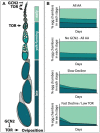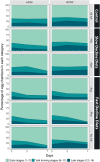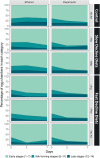Target of Rapamycin Drives Unequal Responses to Essential Amino Acid Depletion for Egg Laying in Drosophila Melanogaster
- PMID: 35252188
- PMCID: PMC8888975
- DOI: 10.3389/fcell.2022.822685
Target of Rapamycin Drives Unequal Responses to Essential Amino Acid Depletion for Egg Laying in Drosophila Melanogaster
Abstract
Nutrition shapes a broad range of life-history traits, ultimately impacting animal fitness. A key fitness-related trait, female fecundity is well known to change as a function of diet. In particular, the availability of dietary protein is one of the main drivers of egg production, and in the absence of essential amino acids egg laying declines. However, it is unclear whether all essential amino acids have the same impact on phenotypes like fecundity. Using a holidic diet, we fed adult female Drosophila melanogaster diets that contained all necessary nutrients except one of the 10 essential amino acids and assessed the effects on egg production. For most essential amino acids, depleting a single amino acid induced as rapid a decline in egg production as when there were no amino acids in the diet. However, when either methionine or histidine were excluded from the diet, egg production declined more slowly. Next, we tested whether GCN2 and TOR mediated this difference in response across amino acids. While mutations in GCN2 did not eliminate the differences in the rates of decline in egg laying among amino acid drop-out diets, we found that inhibiting TOR signalling caused egg laying to decline rapidly for all drop-out diets. TOR signalling does this by regulating the yolk-forming stages of egg chamber development. Our results suggest that amino acids differ in their ability to induce signalling via the TOR pathway. This is important because if phenotypes differ in sensitivity to individual amino acids, this generates the potential for mismatches between the output of a pathway and the animal's true nutritional status.
Keywords: GCN2; amino acid sensing pathways; egg chamber development; egg laying dynamics; holidic diet; nutrient signalling; target of rapamycin.
Copyright © 2022 Alves, Sgrò, Piper and Mirth.
Conflict of interest statement
The authors declare that the research was conducted in the absence of any commercial or financial relationships that could be construed as a potential conflict of interest.
Figures







Similar articles
-
Enriching table eggs with n-3 polyunsaturated fatty acids through dietary supplementation with the phototrophically grown green algae Nannochloropsis limnetica: effects of microalgae on nutrient retention, performance, egg characteristics and health parameters.Poult Sci. 2022 Jun;101(6):101869. doi: 10.1016/j.psj.2022.101869. Epub 2022 Mar 24. Poult Sci. 2022. PMID: 35477136 Free PMC article.
-
A holidic medium for Drosophila melanogaster.Nat Methods. 2014 Jan;11(1):100-5. doi: 10.1038/nmeth.2731. Epub 2013 Nov 17. Nat Methods. 2014. PMID: 24240321 Free PMC article.
-
Choline and methionine supplementation in layer hens fed flaxseed: effects on hen production performance, egg fatty acid composition, tocopherol content, and oxidative stability.Poult Sci. 2021 Sep;100(9):101299. doi: 10.1016/j.psj.2021.101299. Epub 2021 May 29. Poult Sci. 2021. PMID: 34271229 Free PMC article.
-
Effect of level of fiber of the rearing phase diets on egg production, digestive tract traits, and body measurements of brown egg-laying hens fed diets differing in energy concentration.Poult Sci. 2016 Aug 1;95(8):1836-47. doi: 10.3382/ps/pew075. Epub 2016 Mar 14. Poult Sci. 2016. PMID: 26976899
-
Effect of Oils in Feed on the Production Performance and Egg Quality of Laying Hens.Animals (Basel). 2021 Dec 7;11(12):3482. doi: 10.3390/ani11123482. Animals (Basel). 2021. PMID: 34944258 Free PMC article. Review.
Cited by
-
A High-Throughput Method for Quantifying Drosophila Fecundity.Toxics. 2024 Sep 9;12(9):658. doi: 10.3390/toxics12090658. Toxics. 2024. PMID: 39330586 Free PMC article.
-
Biosynthetic constraints on amino acid synthesis at the base of the food chain may determine their use in higher-order consumer genomes.PLoS Genet. 2023 Feb 13;19(2):e1010635. doi: 10.1371/journal.pgen.1010635. eCollection 2023 Feb. PLoS Genet. 2023. PMID: 36780875 Free PMC article.
-
An evolutionary mechanism to assimilate new nutrient sensors into the mTORC1 pathway.bioRxiv [Preprint]. 2023 May 26:2023.05.25.541239. doi: 10.1101/2023.05.25.541239. bioRxiv. 2023. Update in: Nat Commun. 2024 Mar 21;15(1):2517. doi: 10.1038/s41467-024-46680-3. PMID: 37292894 Free PMC article. Updated. Preprint.
-
Early-adult methionine restriction reduces methionine sulfoxide and extends lifespan in Drosophila.Nat Commun. 2023 Dec 5;14(1):7832. doi: 10.1038/s41467-023-43550-2. Nat Commun. 2023. PMID: 38052797 Free PMC article.
-
Transiently restricting individual amino acids protects Drosophila melanogaster against multiple stressors.Open Biol. 2024 Aug;14(8):240093. doi: 10.1098/rsob.240093. Epub 2024 Aug 7. Open Biol. 2024. PMID: 39106944 Free PMC article.
References
-
- Armstrong A. R., Laws K. M., Drummond-Barbosa D. (2014). Adipocyte Amino Acid Sensing Controls Adult Germline Stem Cell Number via the Amino Acid Response Pathway and Independently of Target of Rapamycin Signaling in Drosophila . Development 141 (23), 4479–4488. 10.1242/dev.116467 - DOI - PMC - PubMed
-
- Bates D. M., Watts D. G. (1988). Nonlinear Regression Analysis and its Applications, 2. New York: Wiley, 219–220.
-
- Behmer S. T., Raubenheimer D., Simpson S. J. (2001). Frequency-dependent Food Selection in Locusts: a Geometric Analysis of the Role of Nutrient Balancing. Anim. Behav. 61 (5), 995–1005. 10.1006/anbe.2000.1695 - DOI
-
- Brown E. H., King R. C. (1964). Studies on the Events Resulting in the Formation of an Egg Chamber in Drosophila melanogaster . Growth 28, 41–81. - PubMed
LinkOut - more resources
Full Text Sources
Molecular Biology Databases

